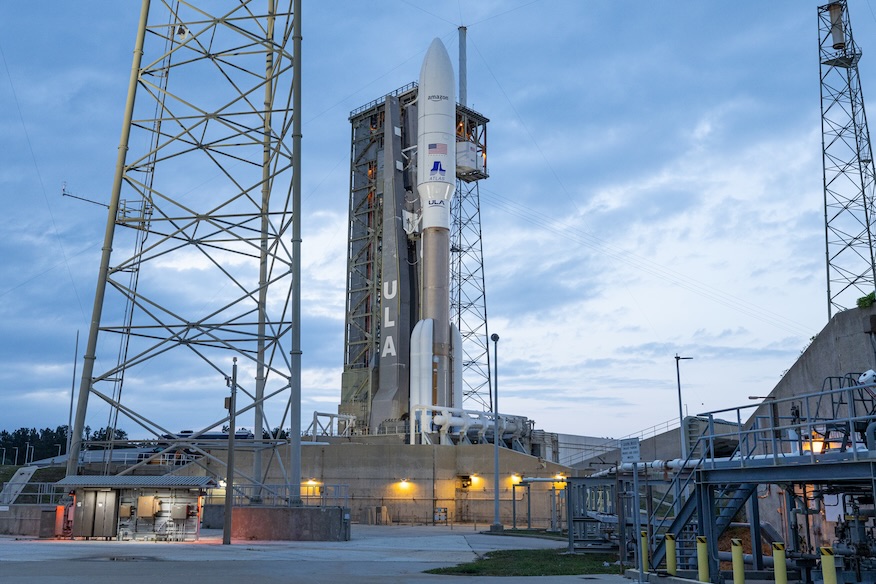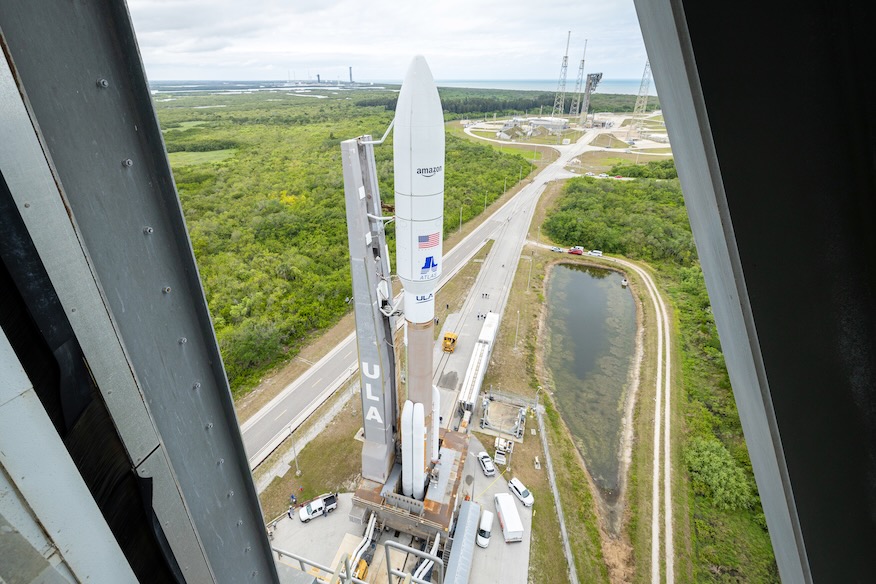
A band of off-shore thunderstorms forced United Launch Alliance to scrub a launch attempt of the first of dozens of missions on behalf of its largest commercial customer, Amazon. Its Atlas 5 551 rocket will carry 27 Project Kuiper satellites onboard.
The mission, referred to as Kuiper 1 by ULA and Kuiper Atlas 1 (KA-01) by Amazon, will send the first batch of its full production satellites into low Earth orbit. Amazon’s satellite internet constellation, called Project Kuiper, is designed to rival others, like SpaceX’s Starlink and Eutelsat’s OneWeb.
A new launch date is being determined by ULA and the Eastern Range.
On Tuesday, the 45th Weather Squadron, based at Patrick Space Force Base, forecast a 55 percent chance for favorable weather, with concerns related to cumulus clouds, strong liftoff winds and the potential impact of isolated showers. That outlook is slightly worse than what was forecast on Monday.
“The cold front, which has brought scattered showers and isolated thunderstorms to central Florida this morning, is expected to be east of the Bahamas by Wednesday evening,” meteorologists wrote. “A developing low along that boundary, coupled with ridging behind the front should bring breezy onshore flow and isolated, fast-moving showers to the Cape for the launch window.”
Launch weather officers however, throughout the course of the launch window, weather remained at an 80 percent probability of violating weather with a combination of strong winds and the proximity of the off-shore storms.
Once it lifts off from the pad, ULA’s Atlas 5 rocket will fly in a north-easterly trajectory.

ULA is using its most powerful Atlas 5 configuration, 551, which features five solid rocket boosters from Northrop Grumman.
Including this mission, Amazon has eight remaining Atlas 5 rockets that it purchased to launch its Kuiper satellites. In a media roundtable on Monday, ULA President and CEO Tory Bruno said the company might launch another Kuiper Atlas mission in the late spring or early summer timeframe before shifting to their first national security mission on a Vulcan rocket.
When asked if ULA expected to go through all eight of Amazon’s Atlas rocket missions this year, Bruno said, “Maybe, not necessarily. I don’t think I’ll get all of the Atlases off for them this year. I think it’ll be ’26 before we get them all done,” he said.
Bruno said they are looking at late summer for the first launch of Kuiper satellites on a Vulcan rocket, which would carry 45 Kuiper satellites on board. The next two launches of Vulcan are planned for missions from its National Security Space Launch (NSSL) Phase 2 contract. USSF-106 will launch first, followed by USSF-87.
“There will be several of each [Vulcan and Atlas] and that should take Amazon well on their way to where they have enough spacecraft for revenue generation, which really means the initial services being offered, which is pretty exciting,” Bruno said.
Bruno expects ULA will launch somewhere in the area of 11-13 or so missions before the end of the year, with there being roughly an equal split between Atlas and Vulcan flights. Those will be a mixture of launches for the U.S. government and Amazon.
Project Kuiper emerges
The Project Kuiper constellation will eventually consist of more than 3,200 satellites in low Earth orbit. Like SpaceX’s Starlink, Amazon wants to have a large constellation to provide low latency internet for commercial customers, both civilian and governmental.
“We have set out to design the most advanced satellite network ever built and we have created the whole thing in house at Amazon,” said Rajeev Badyal, the vice president of Technology for the Kuiper Satellite Network, in an Amazon-produced video. “You need just about every technology area to contribute to build the satellite, the propulsion system, the solar arrays, the silicon, the phased array antennas, the optical inter-satellite links.”
The Kuiper 1 mission will carry the first full production satellites for Project Kuiper. Amazon launched two prototype satellites on another Atlas 5 rocket back in October 2023 to test the capabilities and give Project Kuiper better insight into some changes needed for the final version.

According to stipulations from the Federal Communications Commission (FCC), Amazon said it will begin customer service once the first 578 satellites are launched and operational.
The 3,236 satellites will be spread across 98 orbital planes at 590 km, 610 km and 630 km in altitude. For comparison, the International Space Station orbits between 370-460 km in altitude.
“It might not all go perfectly, but we have an incredible commitment to this project and an incredible team committed to this mission,” Badyal said.
Beyond the Atlas 5 rockets it purchased, Amazon also bought 38 launches on ULA’s Vulcan rocket as well as a combined 33 launches on Arianespace’s Ariane 6, Blue Origin’s New Glenn and SpaceX’s Falcon 9 rockets.
Offering a service to regular people and businesses isn’t Amazon’s only aim. The company also established Kuiper Government Solutions (KGS) LLC as a legally separate entity from Project Kuiper.
Amazon said KGS is designed “to support specialized government capabilities, from secure terrestrial broadband to in-space networking solutions using the Kuiper commercial network.”
KGS and L3Harris Technologies announced a partnership on Monday to offer a combined service for government needs. In pitching this to prospective government customers, L3Harris said that it brings “Proven, resilient open systems from SATCOM terminals to robust tactical radios (to) ensure seamless integration into your existing operations.”
“The synergies of our new partnership will deliver out-of-the-box interoperability and specialized systems for military, public safety and commercial applications, providing customers more flexibility in their communication networks than ever before,” said Sam Mehta, President, Communication Systems for L3Harris, in a statement. “This partnership is crucial for providing extended, enhanced capabilities not available today and reinforces our mutual commitment to deliver resilient, secure and trusted solutions to our customers.”
source: spaceflightnow.com